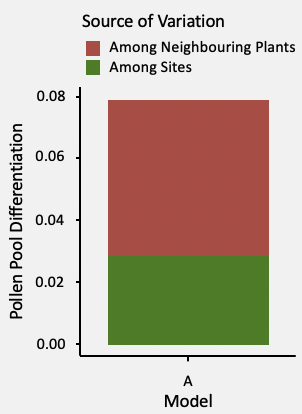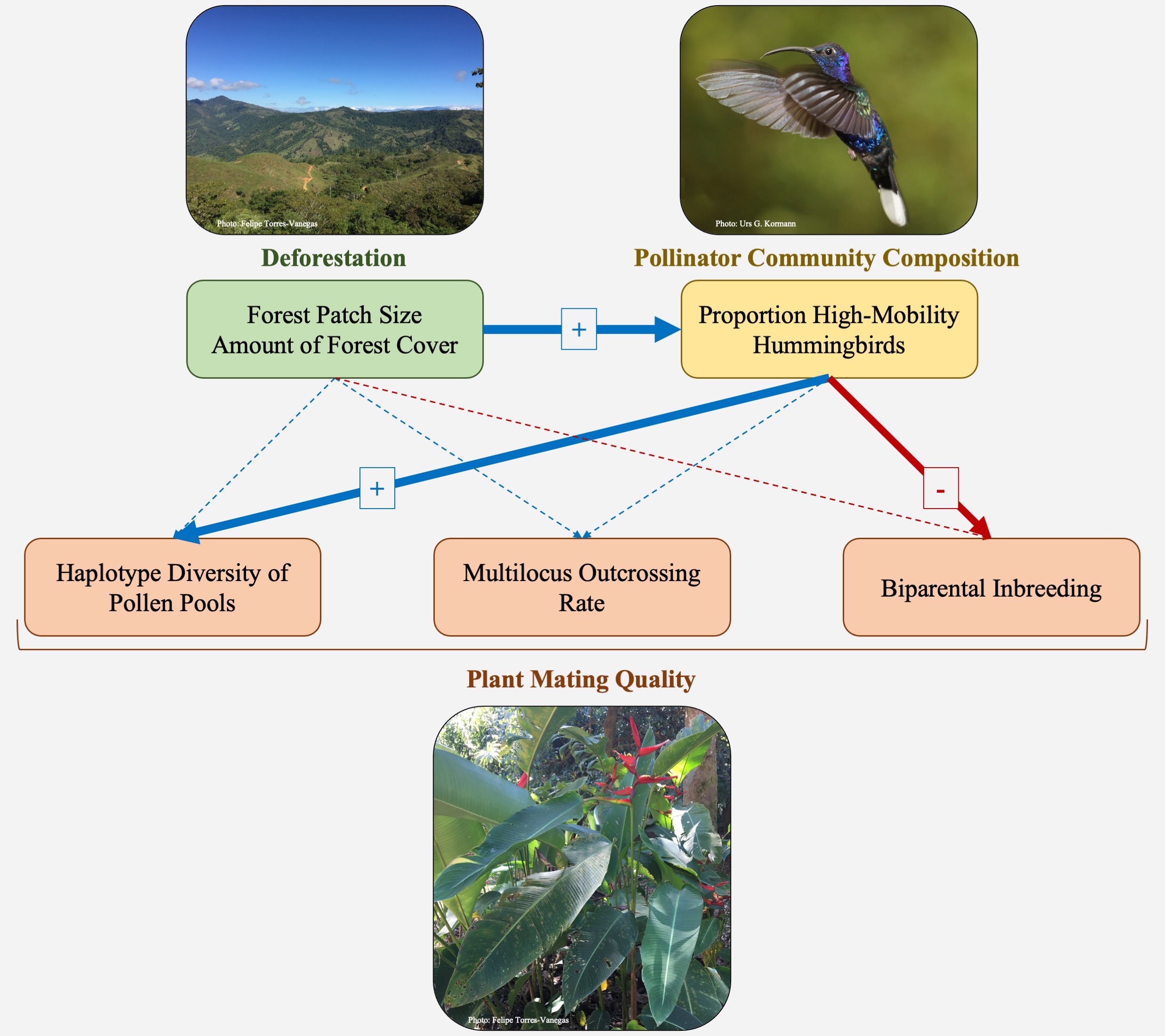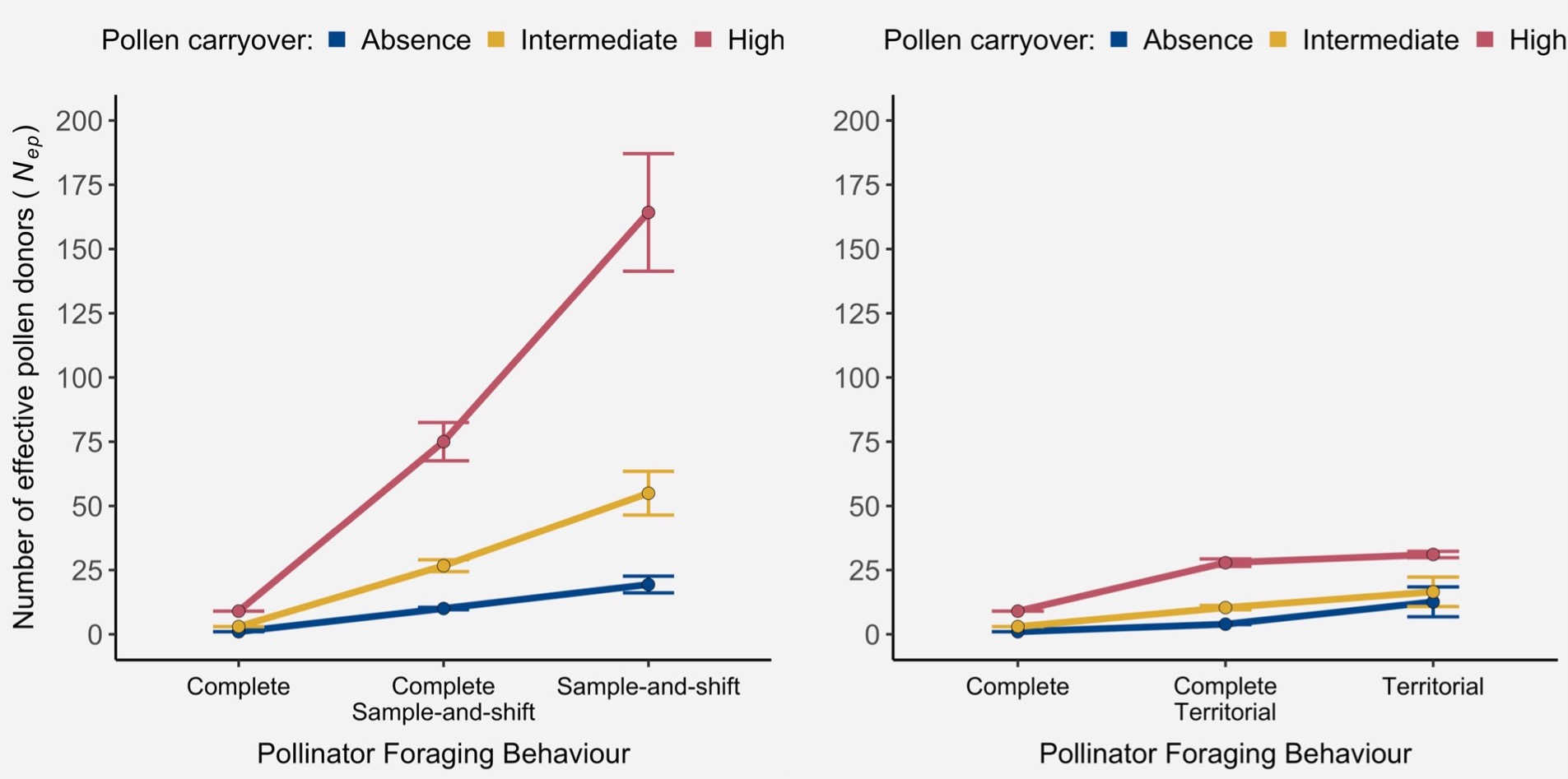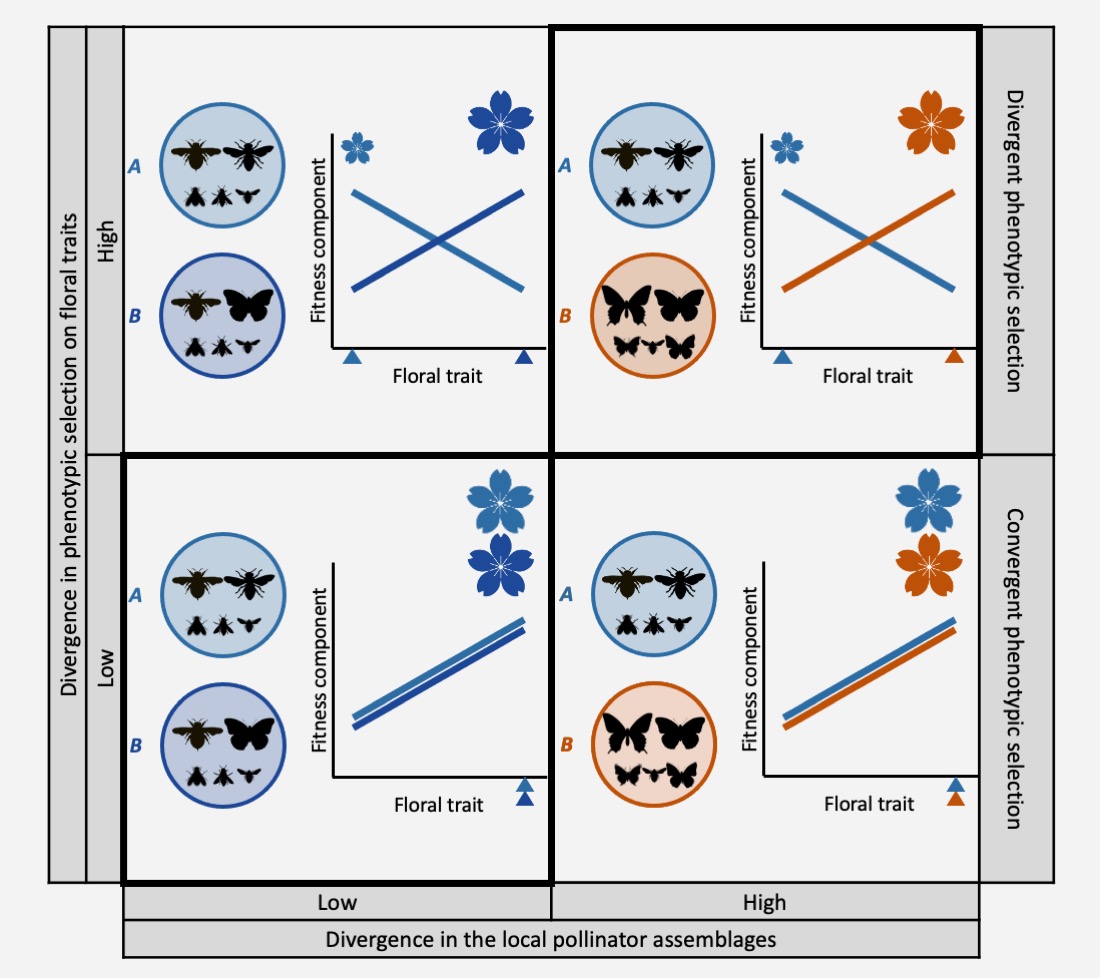Genetic Consequences of Pollination Mode
Background
Most species of flowering plants depend on animals for successful pollination. The resulting myriad of plant-pollinator interactions has given rise to a great diversity of complex pollination networks. However, different functional groups of floral visitors vary widely in their effectiveness as pollinators, leading to a reduction in the number of realized pollinators and an increase in the degree of plant-pollinator specialization. This cryptic specialization may increase the susceptibility of pollination to the decline of particular species of pollinators. I am interested in understanding how different functional groups of pollinators contribute to pollination success.
Specifically, I address the following questions:
- How does pollinator behaviour affect pollen dispersal and genetic diversity?
- To what extent is functional replacement of different pollinator species possible?
- What proportion of pollination is undertaken by particular functional groups of pollinators?
The Landscape Genetic Signature of Pollination by Trapliners
My research suggests that patterns of contemporary pollen-mediated gene flow in the tropical herb Heliconia tortuosa are consistent with the foraging strategy of its traplining hummingbird pollinators. Estimates of pollen pool differentiation among neighbouring maternal plants were about two times higher than estimates of pollen pool differentiation among sites. I argue that this hierarchical pattern of pollen pool differentiation is a landscape genetic signature of the traplining foraging strategy. Although H. tortuosa is visited by multiple species of hummingbirds, my research suggests that this pollination network has high cryptic specialization, where successful pollination largely comes from the few traplining hummingbird species. This cryptic reduction in the number of realized pollinators potentially increases the vulnerability of pollination success to the decline of populations of traplining hummingbirds, which have been shown to be sensitive to forest fragmentation.

Effects of Deforestation on Plant Mating
Background
Inadequate pollen quality can substantially reduce seed production and compromise plant reproductive success and population viability. Reductions in pollen quality can decrease the likelihood of beneficial genotype combinations among the progeny, resulting in less vigorous offspring with lower germination rates, competitive abilities, and survival probabilities. As such, characterizing the mechanisms that govern variation in pollen quality is essential to understand the ecological and evolutionary dynamics of plant reproduction.
Specifically, I address the following questions:
- What factors influence the composition of pollinator species at the community level?
- How do changes in the composition of the pollinator community influence the quality of the pollination service?
- How does rapid global change influence plant population dynamics and long-term viability?
Deforestation Reduces Plant Mating Quality by Shifting the Composition of Pollinator Communities
My research suggests that deforestation influences plant mating quality through a cascading effect mediated by functional shifts in the composition of the pollinator community. My results indicate that plant mating quality strongly depends on the composition of local pollinator communities. Functional shifts that filter out highly mobile and effective pollinators may reduce the transfer of genetically diverse pollen loads from unrelated plants. Such shifts may have pronounced effects on plant population dynamics and disrupt genetic connectivity.

Pollinator Behaviour and Plant Mating Systems
Background
Due to their immobility, hierarchical modular architecture, and hermaphroditism, the vast majority of flowering plants present complex and versatile mating patterns, often involving interactions with diverse communities of animal pollinators. As such, maternal plants are likely to produce progeny sired by multiple pollen donors. A central goal in the study of plant mating patterns is thus to determine who mates with whom and to identify the means by which mating occurs. In order to generate a more comprehensive understanding of plant mating systems, I am interested in linking plant mating patterns with pollinator foraging behaviour and pollinator functional traits.
Specifically, I address the following questions:
- How do functionally distinct pollinator foraging behaviours influence the ecology and evolution of plant mating systems?
- Is mating more likely to occur among near neighbours or does it occur across long-distances?
- Do plants have any control over whom they mate with?
Foraging Tactics by Pollinators Have Divergent Consequences for Plant Mating Systems
My research suggests that pollinators may adopt a combination of foraging tactics that likely depend on the ecological context. Importantly, the particular foraging tactics adopted by pollinators have divergent consequences for multiple paternity and near-neighbour mating. Indeed, my research demonstrates that even a minor modification in the particular foraging tactic adopted by pollinators can have important consequences for plant mating system parameters. This finding highlights the relevance of the dynamics and complexities of pollinator foraging behaviour as a driver of the ecology and evolution of plant mating systems. My research provides a framework to understand the impact of conceptualized parameters of pollinator foraging on plant mating systems, which accounts for the interplay between pollinator foraging tactics and the mechanics of pollen removal and deposition.

Phenotypic Selection on Floral Traits
Background
Divergent patterns of phenotypic selection on floral traits can arise in response to interactions with functionally distinct pollinators. However, there are a limited number of studies that relate patterns of phenotypic selection on floral traits to variation in local pollinator assemblages in pollination-generalized plant species. I studied phenotypic selection on floral traits of Viscaria vulgaris, a plant that interacts with a broad range of diurnal and nocturnal pollinators, and related divergence in phenotypic selection on floral traits to the expected level of divergence in local pollinator assemblages.
Specifically, I address the following questions:
- Is there phenotypic selection in a study system with generalized plant-pollinator interactions?
- Is there spatial and temporal variation in the strength and direction of phenotypic selection?
- How does divergence in the strength and direction of phenotypic selection relate to the expected level of divergence in local pollinator assemblages?
The Local Pollinator Assemblage and Phenotypic Selection
My research detected phenotypic selection on floral traits involved in the attraction of pollinators and the mechanics of pollen removal and deposition, and demonstrated that floral traits are subject to spatiotemporal variation in the strength and direction of phenotypic selection. We revealed that diurnal and nocturnal pollinators, when considered in isolation, mediated divergent patterns of phenotypic selection on floral traits. My research indicated that divergence in phenotypic selection on floral traits increased with the expected level of divergence in local pollinator assemblages. Thus, generalized plant-pollinator interactions can mediate phenotypic selection on floral traits and distinct local pollinator assemblages can generate a geographic mosaic of divergent patterns of phenotypic selection.

